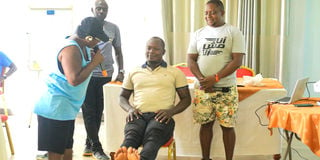USF applaud Usca for improving standards

Improvising. Yuda Morris Ssekamatte shows how to float with a kickboard between one's legs. PHOTOS/RASHID MATOVU
What you need to know:
The coaches had a feel of that in the practical sessions as they went through some drills right from the basics of floating on the back.
Coaches under their Uganda Swimming Coaches Association umbrella reconvened for the second time in a fortnight for their backstroke school.
The freestyle school on October 12 had over 60 participants and almost the same number turned up for backstroke, including four from Mukono, on Saturday at Hotel Le Grande, Bwaise.
“There is a thirst for knowledge and certification,” Usca president Allan Kiiza shared.
“Most of these participants are fresh graduates or former athletes trying to ensure they teach the right things when they are put in the right place,” Kiiza, who coaches at Dolphins, added.
Backstroke definitely looked more challenging than freestyle and the coaches are braced for even tougher sessions in the breaststroke (November 9) and butterfly (yet to be determined as some will travel for the Africa Aquatics Zone III Championships in Burundi due November 21-24) schools.
“From watching our competitions, you realize that everyone has their ideas on body positioning, arm movements and coordination,” Usca general secretary and coach at Sailfish Joseph Kabogoza, said.
Ozpreys coach Charles Kasaga opened the can of worms when he commented that when he watches international competitions, swimmers seem not to stress about having their arms enter straight in the water.

Get it right. Anne Mandre (L), Mubarak Ssemanda (sitting) demonstrate the backstroke's leg position.
“Winning is about who touches first and most of the record holders or champions have an issue in their development so they manipulate the stroke, as long as they do not break the rules to be disqualified, to take care of their defects,” Dolphins coach and the day’s trainer Tonnie Kasujja shared.
Kabogoza also interjected that “there is always the ideal stroke. But it will not work for everyone as some people are just designed differently.”
The coaches had a feel of that in the practical sessions as they went through some drills right from the basics of floating on the back.
“In backstroke, some people fight the water and pull out their chests, which causes their heads to go down, hence struggling to float. When one struggles to float on the back, let them try floating on the sides or improvise by putting equipment like a kickboard between their legs.
“Gradually, you introduce drills, kicking, and hand movements. When you create movement, you increase the upthrust (buoyance) and surface area and reduce gravitational pull. When you kick, it exerts pressure and reduces the gravitational pull and you are able to float,” Kasujja told the trainers.
Yuda Morris Ssekamatte was one of those who did the practical session but despite struggles here and there, due to his body mass, he got “two or three new drills that can work for the kids because they have lighter bodies.”
Uganda Swimming Federation (USF) president Moses Mwase, said they “are proud of Usca for the stroke schools because this good initiative will help to improve our standards and how we teach our children.”




